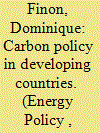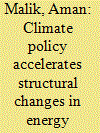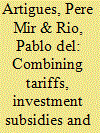|
|
|
Sort Order |
|
|
|
Items / Page
|
|
|
|
|
|
|
| Srl | Item |
| 1 |
ID:
109319


|
|
|
|
|
| Publication |
2011.
|
| Summary/Abstract |
Welfare analyses of energy taxes typically show that systems with uniform rates perform better than differentiated systems. However, most western countries include some exemptions for their energy-intensive export industries and thereby avoid this potential welfare gain. Böhringer and Rutherford (1997) find that uniform taxation of carbon emissions in combination with a wage subsidy preserves jobs in these industries at a lower welfare cost compared with a differentiated system. The wage subsidy scheme generates a substantial welfare gain per job saved. This study, however, finds that welfare costs are substantial when less accurate policy measures, represented by production-dependent subsidies, protect jobs in Norwegian electricity-intensive industries. The welfare cost per job preserved by this subsidy scheme amounts to approximately 60% of the wage cost per job, suggesting that these jobs are expensive to preserve. A uniform electricity tax combined with production-dependent subsidies preserves jobs at a lower welfare cost compared with the current differentiated electricity tax system.
|
|
|
|
|
|
|
|
|
|
|
|
|
|
|
|
| 2 |
ID:
171378


|
|
|
|
|
| Summary/Abstract |
Energy subsidies cost Ecuador 7% of its public budget, or two thirds of the fiscal deficit. Removing these subsidies would yield local economic and environmental benefits and help implement climate targets set in the Paris Agreement. However, adverse effects on vulnerable households can make subsidy reforms politically difficult. To inform policy design, we assess the distributional impacts of energy subsidy reform using Ecuadorian household data and an augmented input-output table. We find that subsidy removal without compensation would be regressive for diesel and LPG, progressive for gasoline, and approximately neutral for electricity. We then analyze how freed up public revenues could fund in-kind and in-cash compensation schemes to mitigate income losses for poor households. Our results indicate that removing all energy subsidies and increasing the cash transfer program, Bono de Desarrollo Humano (BDH), by nearly US$ 50 per month would increase the real income of the poorest quintile by 10% while leaving more than US$ 1.3 billion for the public budget. Finally, we conduct interviews with local policy makers and experts to identify two reform options that are progressive and considered feasible: eliminating subsidies on gasoline while increasing the BDH and replacing universal LPG subsidies with targeted LPG vouchers.
|
|
|
|
|
|
|
|
|
|
|
|
|
|
|
|
| 3 |
ID:
166989


|
|
|
|
|
| Summary/Abstract |
Carbon pricing might not be appropriate as the main element of the carbon policy package in emerging and developing countries (DCs), because the political economy constraints are greater than in developed countries. Non-price instruments and policies such as efficiency standards, market-oriented regulation, subsidies for clean technologies and public programs involving low carbon infrastructure should be preferentially developed to deal with market and regulatory failures, which are more widespread than in developed countries. These approaches are most effective in orientating technology and infrastructure, the principal means to achieving the mitigation imperative in DCs. Moreover, even if, in theory, policy packages using non-price instruments are less socially efficient than those focused on carbon pricing, they allow governments to circumvent political economy constraints, because their costs to consumers and citizens are not generalized and tend to be much less visible, while their redistributive effects are, if appropriately designed, generally not too regressive. In the end, developing a carbon policy that emphasizes non-price instruments and measures will pave the way to leverage carbon pricing as the main pillar of their future carbon policy in long term.
|
|
|
|
|
|
|
|
|
|
|
|
|
|
|
|
| 4 |
ID:
181787


|
|
|
|
|
| Summary/Abstract |
The employment implications of decarbonizing the energy sector have received far less attention than the technology dimension of the transition, although being of critical importance to policymakers. In this work, we adapt a methodology based on employment factors to project future changes in quantity and composition of direct energy supply jobs for two scenarios - (1) relatively weak emissions reductions as pledged in the nationally determined contributions (NDC) and (2) stringent reductions compatible with the 1.5 °C target. We find that in the near-term the 1.5°C-compatible scenario results in a net increase in jobs through gains in solar and wind jobs in construction, installation, and manufacturing, despite significant losses in coal fuel supply; eventually leading to a peak in total direct energy jobs in 2025. In the long run, improvements in labour productivity lead to a decrease of total direct energy employment compared to today, however, total jobs are still higher in a 1.5 °C than in an NDC scenario. Operation and maintenance jobs dominate future jobs, replacing fuel supply jobs. The results point to the need for active policies aimed at retraining, both inside and outside the renewable energy sector, to complement climate policies within the concept of a “just transition”.
|
|
|
|
|
|
|
|
|
|
|
|
|
|
|
|
| 5 |
ID:
132678


|
|
|
|
|
| Publication |
2014.
|
| Summary/Abstract |
Policy combinations and interactions have received a considerable attention in the climate and energy policy realm. However, virtually no attention has been paid to the analysis of the combination of different deployment instruments for the same renewable energy technology. This neglect is all the more striking given the existence in current policy practice of combinations of deployment instruments either across technologies or for the same technology, both in the EU and elsewhere. What renewable electricity support policies to use and, therefore, how to combine them in order to promote the deployment of renewable energy technologies cost-effectively is a main concern of governments. The aim of this paper is to provide insight on the cost-effectiveness of combinations of deployment instruments for the same technology. A financial model is developed for this purpose, whereby feed-in tariffs (FITs) are combined with investment subsidies and soft loans. The results show that the policy costs of combinations are the same as for the FITs-only option. Therefore, combining deployment instruments is not a cost-containment strategy. However, combinations may lead to different inter-temporal distributions of the same amount of policy costs and, thus, differently affect the social acceptability and political feasibility of renewable energy support.
|
|
|
|
|
|
|
|
|
|
|
|
|
|
|
|
| 6 |
ID:
121396


|
|
|
|
|
| Publication |
2013.
|
| Summary/Abstract |
Norway has great potential for producing pumped-storage hydropower, and the European Union (EU) hope Norway can contribute to Europe's transition to a renewable energy system by serving as a 'green battery'. This is certainly technically feasible. However, this paper asks whether the green battery idea is politically feasible. The paper analyses four scenarios, three of which Norway serves as a green battery and one domestic. It focuses on decision-makers' and interest groups' positions on new interconnectors from Norway to continental Europe and the United Kingdom (UK), pumped-storage hydropower, and new renewable energy production in Norway. The paper argues that the present policy is characterised by incremental change-decisions about new interconnectors are made on an individual basis. Moreover the paper argues there is little reason to believe that this status quo policy will change based on any of the green battery scenarios in the near term. Still, decision-makers and interest groups are positive, in principle, towards new interconnectors and pumped-storage hydropower. Hence, Norway might become a green battery in the longer term. In the short term, however, a politically feasible contribution from Norway is balancing power through already existing hydropower capacity.
|
|
|
|
|
|
|
|
|
|
|
|
|
|
|
|
|
|
|
|
|